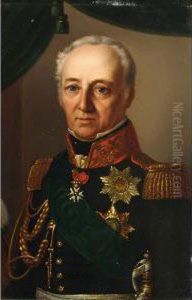Ferdinand Von Raysk Paintings
Ferdinand von Rayski, born on October 14, 1806, in Pegau near Leipzig, was a notable German portrait painter associated with the Düsseldorf school of painting. His artistic journey began at the Dresden Academy, where he studied under the guidance of Julius Schnorr von Carolsfeld. He later moved to Munich in 1826, where he continued his studies and began to establish his reputation as a skilled portraitist.
Von Rayski's work is characterized by its meticulous attention to detail and its subtle yet powerful portrayal of the human character. His portraits are known for their psychological depth and often reflect the social and cultural attitudes of his time. He was particularly adept at capturing the nuances of facial expression and the textures of fabrics and materials, which lent a lifelike quality to his paintings.
Throughout his career, von Rayski was commissioned to paint portraits of many important figures of the day, including members of the nobility, politicians, and intellectuals. His work brought him considerable fame and recognition, and he was celebrated as one of the finest portrait painters of the 19th century in Germany.
Despite his success, von Rayski preferred a quiet life and spent much of his time in Dresden, away from the bustling art scenes of Berlin or Munich. He was an introspective man, and his portraits are often reflective of his contemplative nature. Von Rayski's legacy is preserved in the numerous portraits that hang in galleries and museums across Germany, serving as a testament to his talent and his contribution to the art of portraiture.
Ferdinand von Rayski died on November 23, 1890, in Loschwitz near Dresden. His body of work remains an important part of German art history and continues to be studied and admired for its technical mastery and its insightful representation of 19th-century European society.
